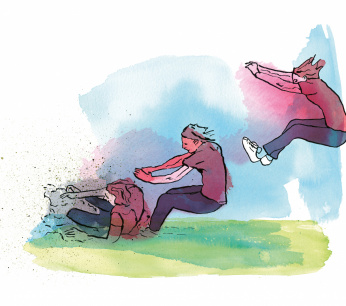Occupational Health and Safety Catalog for MBO sets requirements for safe and healthy work
Too much work pressure, bad climate, danger in the practical classroom, these do not belong in education. Staff in secondary vocational education can now easily and precisely look up what the working conditions should be in their own Arbocatalogue.

image: Nanne Meulendijks
First remove a misunderstanding, says Koen Langenhuysen, occupational health and safety expert at Fijn-Werk. “The Occupational Health and Safety Catalog is not a non-binding guide from which employers and employees choose what they like. These are binding regulations that the employer must comply with. There is also guidance for staff to work safely and not endanger others.”
The advantage of the current Occupational health and safety catalog MBO: the extensive rules and regulations are divided over a website with themes that are directly related to professional practice: from emergency response and biological agents to practice rooms and workload. “Look there first if you have the impression that something is not right, or look there anyway to find out whether your workplace meets the requirements,” advises Langenhuysen, who has edited the texts of the MBO catalog on behalf of employers and employee organizations. was responsible for. “Look with common sense, ask yourself what an outsider would think of your working conditions. And also look at your own expertise, is it still up to date in your field?”
In motor vehicle technology, there are requirements for the lifting bridge
This concerns all workplaces: the desks and screens in the administration, the theory rooms, the places for support staff and the practical rooms where students learn to practice their profession with real machines and materials. Safety regulations and instruction cards are essential there. “In motor vehicle technology there are requirements for the lifting bridge, if you are going to solder in visual arts, this must be done carefully and for sawing and sanding machines there are a lot of regulations on how to handle them safely as an employee, but also as a student.”
Job catalogs are available for all sectors in education. They are determined in consultation between organizations of employers and employees, and tested by the Dutch Labor Inspectorate. An occupational health and safety catalog is more detailed than general labor legislation. In secondary vocational education, this happens, for example, when there is a risk of contact with blood. In training for care and handling of animals, the employer must offer protective vaccinations not only to staff, but also to students.
Handhold
And if something isn't right? Langenhuysen does not dare to give an occupational health and safety score for secondary vocational education, but he foresees that there is still room for improvement: “If in doubt, look at your own situation with the data from the Occupational Health and Safety Catalogue. This provides guidance to discuss it with your manager. Safety issues can also be discussed in participation.”
Make a plan and start addressing the serious risks
Acute dangers must be addressed quickly, but don't expect too much if the risks are smaller. The employer may spread measures over the years, especially if the institution has several buildings under its care, all of which do not meet the current regulations, for example because they are too small for the current numbers of students, or if the climate control is not yet in order. Langenhuysen: “As staff you have something to exert pressure, because the circumstances do not meet the standards. According to occupational health and safety legislation, the school must take 'reasonable' measures: make a plan and start tackling the serious risks.”
Work pressure is an organizational problem. So it is first of all up to the employer to take measures
Continuing to work safely and healthily is not just about machines and materials, as is also evident from the MBO Working Conditions Catalogue. Social safety and workload management are just as much the institution's responsibilities. Langenhuysen: “On these topics you can also see what is expected of the employer to limit risks, including what comes from outside the organization. Aggressive behavior from students does occur, but it can also come from suppliers or third parties.”
And workload? “That is not an individual issue but an organizational problem. So it is first of all up to the employer to take measures.”
Discuss the workload
Are things going well in secondary vocational education? The figures give a mixed picture, says secretary Henriëtte Kassies of the MBO Labor Market Fund Foundation. On the one hand, satisfaction with working in secondary vocational education is increasing, on the other hand, absenteeism has increased in 2022. “That is generally not a good sign, although absenteeism had actually fallen during the corona period.” She mentions the standards for what is called psychosocial workload and the collective labor agreement agreements on limiting the workload. “This shows that employers and employees are paying attention to this. With good policy, absenteeism should decrease, so this must be improved.”
What to do? “Speak about that workload with colleagues and your manager. That gives you some breathing space, and you often come up with directions for a solution together. Teams that talk well about collaboration and connection progress further.”
If this does not work immediately, the inspiration sessions on the website of the MBO Labor Market Fund Foundation may offer a starting point for strengthening team dialogue. Look at sommbo.nl -> professionalization. Staff members can also ask about healthy and safe work per e-mail. Kassies: “Don't keep workload problems to yourself, make it open to discussion and keep it open for discussion. So don't grumble with that one colleague, but look in your team to see what can work. Whether it is chair massage, time management or attention to positive health.”
Are heavenly working conditions within reach? “Employers usually think that working for them is very pleasant, unions believe that there is a lot of room for improvement. You always keep that nuance in the experience.”


